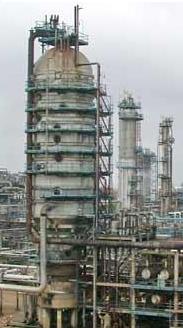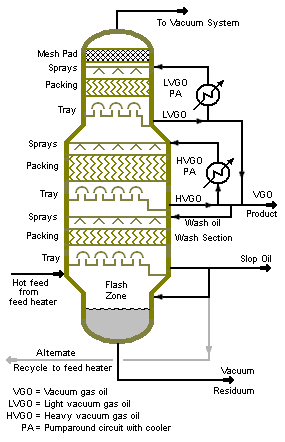User:Milton Beychok/Sandbox: Difference between revisions
imported>Milton Beychok No edit summary |
imported>Milton Beychok No edit summary |
||
| Line 17: | Line 17: | ||
The 10 to 40 mmHg absolute pressure in a vacuum distillation column increases the volume of vapor formed per volume of liquid distilled. The result is that such columns have much larger diameters than columns than columns operating at atmospheric pressure. Distillation columns such those in Figures 1 and 2, may have diameters of 15 meters or more. | The 10 to 40 mmHg absolute pressure in a vacuum distillation column increases the volume of vapor formed per volume of liquid distilled. The result is that such columns have much larger diameters than columns than columns operating at atmospheric pressure. Distillation columns such those in Figures 1 and 2, may have diameters of 15 meters or more. | ||
The vacuum distillation column internals must provide good vapor-liquid contacting while, at the same time, maintaining a very low pressure increase from the top of the column top to the bottom. Therefore, the vacuum column uses [[distillation tray]]s only where withdrawing products from the side of the column (referred to as ''side draws''). Most of the column uses packing material for the vapor-liquid contacting because such packing has a lower pressure drop than | The vacuum distillation column internals must provide good vapor-liquid contacting while, at the same time, maintaining a very low pressure increase from the top of the column top to the bottom. Therefore, the vacuum column uses [[distillation tray]]s only where withdrawing products from the side of the column (referred to as ''side draws''). Most of the column uses packing material for the vapor-liquid contacting because such packing has a lower pressure drop than distillation trays. This packing material can be either [[structured sheet metal]] or randomly dumped packing such as [[Raschig rings]]. | ||
The absolute pressure of 10 to 40 mmHg in the vacuum column is achieved by using multiple stages of steam jet [[ejector]]s | The absolute pressure of 10 to 40 mmHg in the vacuum column is most often achieved by using multiple stages of steam jet [[ejector]]s. <ref>[http://www.graham-mfg.com/ejphotos.html Photo gallery] (from website of Graham Manufacturing Company)</ref> | ||
Many industries, other than the petroleum refining industry, use vacuum distillation on a much a smaller scale. | |||
==Laboratory-scale vacuum distillation== | ==Laboratory-scale vacuum distillation== | ||
Revision as of 17:04, 9 February 2008
Vacuum distillation is distillation of liquids performed at a pressure lower than atmospheric pressure to take advantage of the fact that reducing the pressure lowers the boiling point of liquids. This permits the distillation of liquids that are temperature sensitive and avoids any degradation of such liquids.
Vacuum distillation in petroleum refining
Petroleum crude oil is a complex mixture of hundreds of different hydrocarbon compounds generally having from 3 to 40 carbon atoms per molecule, although there may be small amounts of hydrocarbons outside that range. In refining the crude oil, it is important not to subject the high molecular weight components to temperatures above 370 to 380 °C because they will undergo thermal cracking and form petroleum coke at temperatures above that. Formation of coke would result in plugging the tubes in the furnace that heats the feed stream to a column distilling either the whole crude oil or only the higher molecular weight components of crude oil. Plugging would also occur in the piping from the furnace to the distillation column as well as in the column itself.
The refining of crude oil begins with distilling the incoming crude oil in a so-called atmospheric distillation column operating at pressures slightly above atmospheric pressure. The constraint imposed by limiting the column inlet temperature
to no more than 370 to 380 °C yields a residual oil from the bottom of the atmospheric distillation column consisting entirely of hydrocarbons that boil above 370 to 380 °C.
To further distill the residual oil from the atmospheric distillation column, it is necessary to perform the distillation at absolute pressures as low as 10 to 40 mmHg so as to limit the operating temperature to less than 370 to 380 °C.
Figure 1 is a photograph of a large vacuum distillation column in a petroleum refinery and Figure 2 is a process diagram of a petroleum refinery vacuum distillation column that depicts the internals of the column.
The 10 to 40 mmHg absolute pressure in a vacuum distillation column increases the volume of vapor formed per volume of liquid distilled. The result is that such columns have much larger diameters than columns than columns operating at atmospheric pressure. Distillation columns such those in Figures 1 and 2, may have diameters of 15 meters or more.
The vacuum distillation column internals must provide good vapor-liquid contacting while, at the same time, maintaining a very low pressure increase from the top of the column top to the bottom. Therefore, the vacuum column uses distillation trays only where withdrawing products from the side of the column (referred to as side draws). Most of the column uses packing material for the vapor-liquid contacting because such packing has a lower pressure drop than distillation trays. This packing material can be either structured sheet metal or randomly dumped packing such as Raschig rings.
The absolute pressure of 10 to 40 mmHg in the vacuum column is most often achieved by using multiple stages of steam jet ejectors. [1]
Many industries, other than the petroleum refining industry, use vacuum distillation on a much a smaller scale.
Laboratory-scale vacuum distillation
- ↑ Photo gallery (from website of Graham Manufacturing Company)


